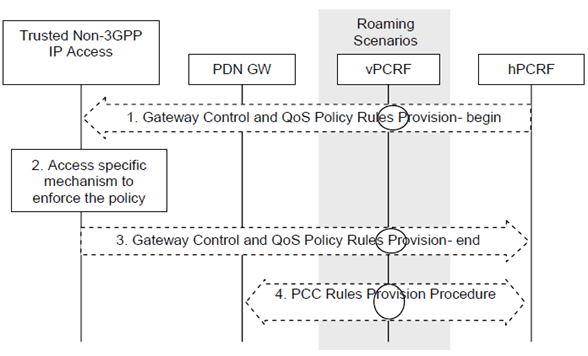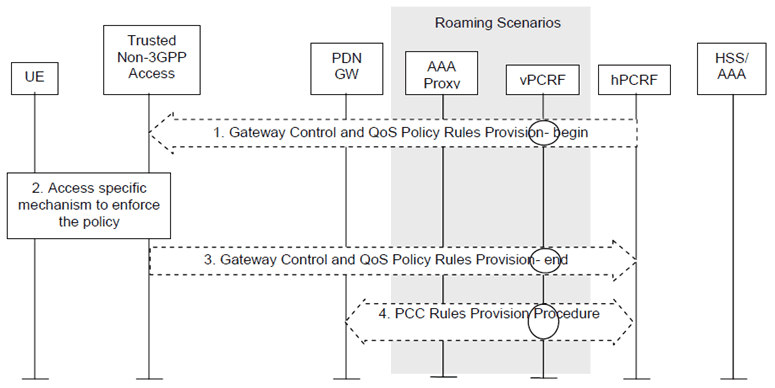Content for TS 23.402 Word version: 18.3.0
0…
4…
4.2…
4.2.2
4.2.3
4.3…
4.4…
4.5…
4.5.7…
4.6…
4.7…
4.7.2…
4.8…
4.8.2a…
4.9…
5…
5.2…
5.4…
5.5
5.6…
5.7…
5.8…
6…
6.2…
6.3
6.4…
6.4.3…
6.5…
6.6…
6.7…
6.8…
6.10…
6.13…
6.15…
7…
7.2…
7.3
7.4…
7.5…
7.6…
7.8…
7.10…
8…
8.2.1.2
8.2.1.3…
8.2.2
8.2.3…
8.2.6…
8.3…
8.4…
8.5…
9…
9.3…
9.4…
10…
13…
16…
16.1.2…
16.1.6…
16.2…
16.2.1a…
16.3…
16.4…
16.7…
16.8…
16.10…
17…
A…
C…
E…
6.6 Network-initiated Dynamic PCC
6.6.1 Network-initiated Dynamic PCC on S2a
6.6.2 Network-initiated Dynamic PCC for S2c over Trusted Non-3GPP IP Access
...
...
6.6 Network-initiated Dynamic PCC p. 139
6.6.1 Network-initiated Dynamic PCC on S2a p. 139
If dynamic PCC is deployed, the procedure given in Figure 6.6.1-1 is used by the PCRF to provision rules to the Trusted non-3GPP IP access and for the Trusted non-3GPP IP access to enforce the policy by controlling the resources and configuration in the trusted non-3GPP access. The access specific procedure executed in the trusted non-3GPP access is not within the scope of this specification.

Figure 6.6.1-1: Network-initiated dynamic policy control procedure in Trusted Non-3GPP IP Access for S2a
(⇒ copy of original 3GPP image)
(⇒ copy of original 3GPP image)
This procedure concerns both the non-roaming (as Figure 4.2.2-1) and roaming case (as Figure 4.2.3-1). In the roaming case, the vPCRF in the VPLMN forwards messages between the Trusted Non-3GPP IP Access and the hPCRF in the HPLMN. In the case of Local Breakout (as Figure 4.2.3-4), the vPCRF forwards messages sent between the PDN-GW and the hPCRF. In the non-roaming case, the vPCRF is not involved at all.
The optional interaction steps between the gateways and the PCRF in the procedures only occur if dynamic policy provisioning is deployed. Otherwise policy may be statically configured with the gateway.
Step 1.
The PCRF initiates the Gateway Control and QoS Policy Rules Provision Procedure specified in TS 23.203 by sending a message with the QoS rules and Event Trigger information to the Trusted non-3GPP access network.
Step 2.
The Trusted Non-3GPP IP Access enforces the rules provisioned to it, and establish all necessary resources and configuration in the non-3GPP access system, e.g. initiate a dedicated bearer activation, modification or deactivation, if supported. The details of this step are out of the scope of this specification.
Step 3.
The Trusted Non-3GPP IP Access responds to the PCRF indicating its ability to enforce the rules provisioned to it in Step 1 and thus completing the GW Control and QoS Rules Provision procedure started in step A.1.
Step 4.
6.6.2 Network-initiated Dynamic PCC for S2c over Trusted Non-3GPP IP Access p. 140
This clause is related to the case when network-initiated dynamic resource allocation is supported, and it is utilized for the S2c traffic flow aggregates.
The procedure described in this clause may also be used subsequent to the S2c Attach procedure described in clause 6.3.
In this case, the PCRF may push specific PCC rules to the PDN-GW and QoS Policy rules to the Trusted Non-3GPP Access system, in case the Access System supports PCC.

Figure 6.6.2-1: Network-initiated dynamic policy control for S2c over Trusted Non-3GPP IP Access
(⇒ copy of original 3GPP image)
(⇒ copy of original 3GPP image)
This procedure concerns both the non-roaming (as Figure 4.2.2-2) and roaming case (as Figure 4.2.3-3). In the roaming case, the vPCRF in the VPLMN forwards messages between the Trusted Non-3GPP IP Access and the hPCRF in the HPLMN. In the case of Local Breakout (as Figure 4.2.3-4), the vPCRF forwards messages sent between the PDN-GW and the hPCRF. In the non-roaming case, the vPCRF is not involved at all.
Steps 1-4 are the same as in steps 1-4 in clause 6.6.1. Step 4 may be skipped in case the PCC rules at the PDN-GW are already up-to-date.